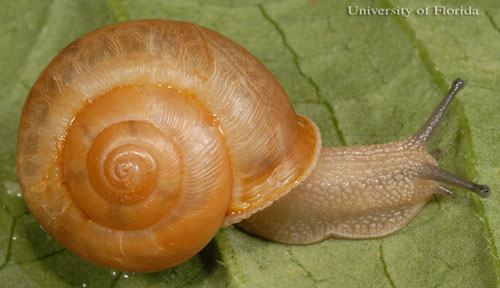Allogona profunda (Say)
Broad-banded Forestsnail
Nutrition
The family of polygyrids are believed to be chiefly mycophagous, which means they are fungus eaters (Pilsbry, 1940). Their food is primarily the mycelia of fungi (Pilsbry, 1940).
In general, terrestrial gastropods have a tendency not to move much, but when they do it's usually only to find food or reproduce (NatureServe, 2011). Olfaction, which refers to the sense of smell, is the primary mechanism used by Allogona profunda (Say) to obtain food (NatureServe, 2011).
This species of land snail was observed, by Walter C. Blinn, ingesting amounts of rotting wood, and he believed they possessed the enzymes necessary to utilize the polysaccharides from the wood (Blinn, 1963). Also, during a walk through the forest he discovered two leaves, ash and elm, which gave evidence of the snail's having fed upon them (Blinn, 1963).
Observations from Walter C. Blinn's study suggest that Allogona profunda (Say) performs a regular spring movement from winter quarters to foraging area every spring after hibernation (Blinn, 1963). Log mold is also very attractive to these snails because of the fungi located there as food, which means it tends to be a common foraging area (Blinn, 1963).
During a study performed by Walter C. Blinn upon this snail, Allogona profunda (Say), after examining and then returning the snails to their chambers, it was given fresh lettuce and water for food (Blinn, 1964). Walter C. Blinn also observed this species of snail reproducing, learn more about the reproduction of Allogona profunda (Say) on the next page.
